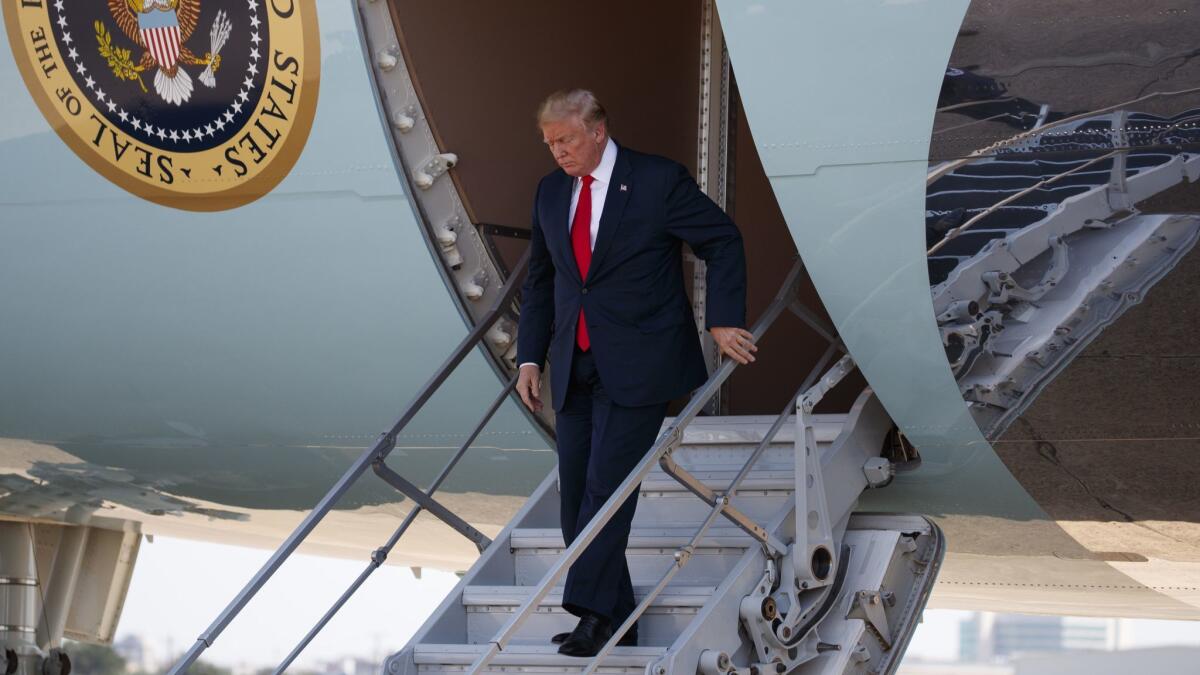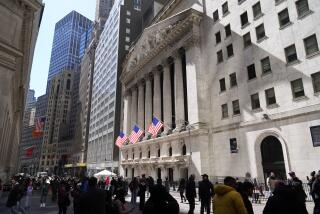Trump’s tweet on solid jobs report breaks protocol aimed at preventing investors from making early trades

For decades, federal officials have taken great care to prevent providing any early indications to investors about monthly jobs report data that can move markets.
On Friday, President Trump broke that longstanding protocol using his favorite communication tool — Twitter — triggering a jump in yields on the 10-year Treasury bond and an outcry from former White House officials.
Trump, who learned about the strong May jobs report Thursday night, tweeted Friday morning that he was “looking forward to seeing the employment numbers” scheduled to be released by the Labor Department about an hour later.
A top White House official emphasized that Trump didn’t reveal any of the numbers, but investors took it as a clear sign the numbers were good. And they weren’t disappointed.
The results showed stronger-than-expected job gains of 223,000 in May with the unemployment rate ticking down to 3.8%, the lowest since 2000.
Trump’s tweet gave investors who were paying attention to Twitter on Friday morning — or who got alerts about Trump’s tweets — a head start on making decisions about stocks and other investments that would be affected by strong numbers.
In tweeting about the report when he did, Trump violated a longstanding prohibition against executive branch officials publicly commenting on the report before its official release or within an hour afterward.
“Except for members of the staff of the agency issuing the principal economic indicator who have been designated by the agency head to provide technical explanations of the data, employees of the Executive Branch shall not comment publicly on the data until at least one hour after the official release time,” according to the White House Office of Management and Budget’s Statistical Policy Directive No. 3, adopted in 1985.
The directive said part of the intent is to “prevent early access to information that may affect financial and commodity markets, and preserve the distinction between the policy-neutral release of data by statistical agencies and their interpretation by policy officials.”
The jobs report is the most significant economic data the government releases each month, with data on the state of the labor market, including wages and the unemployment rate. Investors eagerly await the figures, which are closely guarded.
Journalists get an early look at the report the morning of its release in a special room at the Labor Department with no internet or cellphone access to prevent any news coming out before the official release time.
Friday’s report, which showed job growth that exceeded analyst forecasts and solid wage gains, caused the yield on the 10-year Treasury bond and the Dow Jones industrial average to jump after its formal release.
Those moves reflected investors selling safe securities such as Treasury bonds and moving into riskier but potentially more rewarding stocks in response to a jobs report showing that economic conditions continue to improve.
In March of last year, then-White House Press Secretary Sean Spicer ran afoul of the directive when he took to Twitter 22 minutes after the Bureau of Labor Statistics released the jobs report for the previous month to tout that the 235,000 net jobs gain and the slight decline in the unemployment rate were “great news for American workers.”
Spicer said at the time that his understanding of the rule was that it was designed to avoid affecting the stock market and noted that he was only tweeting the headline numbers that news organizations around the world already had reported.
“I apologize if we’re a little excited and we’re so glad to see so many fellow Americans back at work,” he said.
Since then, Trump administration officials have been careful not to violate the directive. Before Friday, Trump had never tweeted ahead of the jobs report, even when there was stronger job creation than May’s payroll gain.
Former officials from the Obama, Bush and Clinton administrations said Trump’s tweet violated the directive.
“You should have gotten the employment numbers from the Council of Economic Advisers yesterday,” tweeted Jason Furman, who chaired the council under Obama from 2013 until early 2017. “And if this tweet is conveying inside information about a particularly good jobs number you should never get them in advance from the Council of Economic Advisers again.”
But Trump’s top economic advisor, Larry Kudlow, said that the president didn’t violate the directive because he only said he was awaiting the release of the numbers “like everyone else.”
“You can read into that 10 different things if you want to read into it,” Kudlow said on CNBC. “I don’t think he gave anything away, incidentally. I think this was all according to routine, law and custom.”
Kudlow said that, as is custom, the Labor Department gave the jobs report to Kevin Hassett, chairman of the Council of Economic Advisors, on Thursday. Hassett shared the data with Kudlow, who is director of the White House National Economic Council.
“It’s my call whether to send them over to the president. … That’s just what I did last evening,” Kudlow said. “I tracked him down on Air Force One. I wanted him to know the numbers. … He chose to tweet.”
Tony Fratto, a former Treasury and White House official in the George W. Bush administration, objected on Twitter to the assertion by former Obama administration economic official Austan Goolsbee that Trump had divulged classified information.
“What’s illegal is TRADING on the information — depending on how you acquired it,” Fratto tweeted. “It’s not classified information, but it is market sensitive.”
Friday’s jobs report exceeded analyst expectations of payroll gains of about 190,000. April job growth was revised down slightly to 159,000.
“There’s really a lot to like in this report, and it indicates the economy will continue to do well through the rest of this year,” said Gus Faucher, chief economist at PNC Financial Services Group.
Average hourly earnings jumped 8 cents in May to $26.92, the biggest increase since December. For the 12 months ended May 31, wages have increased 2.7%. That is approaching the strong paycheck growth Americans have been awaiting in the recovery from the Great Recession.
“We are seeing better wage gains, and it looks like not just month-to-month, but a consistent upward trend, Faucher said.
Job gains last month were broad-based.
The retail sector, which has been struggling with bankruptcies of once-popular retail chains as Americans buy more online, added 31,100 jobs in May, up from 8,800 the previous month. Healthcare, construction, leisure, hospitality, transportation and warehousing employers also boosted their hiring compared with April.
Manufacturers added 18,000 jobs in May, down from 25,000 the previous month but continuing a rebound in that sector in recent years.
In one negative sign, the percentage of working-age Americans in the labor force declined in May for the third straight month. The 62.7% figure was near a four-decade low.
Twitter: @JimPuzzanghera
UPDATES:
1:35 p.m.: This article was updated with comment from Gus Faucher of PNC Financial Services Group and additional detail.
11:25 a.m.: This article was updated with additional details from the jobs report.
This article was originally published at 8:55 a.m.







